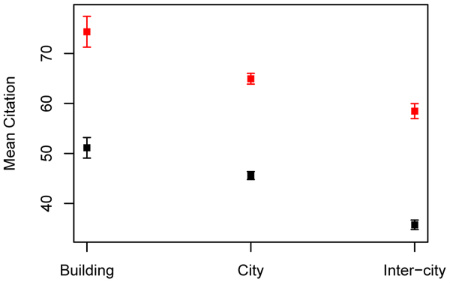

When I wrote about “the death of the office,” I heard a lot of young entrepreneurs say they collaborate very successfully online, often with colleagues and employees who are in different cities or countries. As it turns out, the academic world has seen a similar shift — an explosion of collaboration amongst scientists, with virtual teams forming across date lines. Some scientists make an argument similar to the officeless entrepreneurs: Because Skype and email and wikis and instant messaging make it so easy to collaborate remotely, they can now pick the most talented colleagues to work with irrespective of geographic location. Teams rock harder because you’re no longer stuck, spatially, with the dude down the hallway who’s been on tenure autopilot for two decades. All told, a victory for the intertubes, no?
Ah, but now comes a fascinating study by three scientists at Harvard: “Does Collocation Inform the Impact of Collaboration?” They wondered whether teams that are located in the same place produce papers that have a bigger impact than teams who are disparate. So they gathered info on 35,000 papers in biomedical research where there was at least one Harvard author, calculated where the authors lived, and examined how influential the papers were — based on how many citations they received.
The upshot? Being physically close together is better. Teams that worked in the same place produced papers with a bigger impact than those who lived further apart. This was particularly true when you measure the physical distance between the first and last author of a paper. Check out the scatter plot above: It shows that teams located in the same building did better than teams that were merely in the same city, and teams that were in the same city did better than those that were inter-city.
Why would this be? As the researchers suggest:
There are a number of possible explanations for these associations. It may be that physical proximity truly allows for better collaboration, resulting in higher quality research that tends to be cited more often. It may also be that investigators have a strategic preference for keeping potentially high impact projects wholly within their own laboratory or close circle of research associates.
As they also point out, it’s hard to read too much into these findings. These results may be a quirk of the biomedical sciences, or a result of departmental structure specific to Harvard.
But my guess it that there’s something here. Even in my “end of the office” piece I report on entpreneurs who found that certain types of work are really hard — or perhaps impossible — to do well remotely. One example is doing a big huge rethink of a major part of your business: Several folks told me that if they wanted to tear down a central database and rebuild it, you need everyone in a room together. I know people who’ve redesigned magazines, a task that would have been unfathomable if everyone weren’t in the same conference room. As the science on virtual collaboration emerges, we may find some commonalities between types of work that are best done face to face, and those that work well remotely.
Then again, there may be surprises. I was recently reading The Medici Effect — which is about how to foster creativity — and was surprised to discover that most brainstorming is probably conducted in the wrong way. Generally, people think of “brainstorming” as gathering everyone in a room so they can yell out ideas, with one person writing down the ideas on a whiteboard. But studies show that can shut people down: They get nervous about speaking out loud, or they think their idea isn’t interesting, or one person dominates the brainstorming and drags the center of gravity, for good or ill, in one direction. In contrast, a 1958 study found that if you take the members of your team, put them in different rooms, and ask each to brainstorm solutions to a problem, they’ll produce more and better ideas. That’s because the problems of face-to-face dynamics go away: The “virtual” group is better.

A few years ago I started noticing a strange trend: I’d become interested in a new high-tech startup, so I’d call the founders and ask if I could interview them. They’d say sure, great — why don’t we meet at our local Starbucks? We’d meet, have a great chat; at some point I’d ask if I could see their offices. And then they’d tell me that they didn’t have one. All their employees work from home or in cafes, or are spread across the globe. And I’m not talking here about freelancers and one-person shops; most of these firms were a year or more old, with tons of revenues, sometimes in the millions.
I got interested in this trend, and after investigating it a bit I realized a very interesting shift was going on. The office — the basic atom of corporate existence — was becoming, for many new entrepreneurs, a huge hassle: Either to be avoided entirely, or at least to be put off for as long as possible. It turns out there are some intriguing demographic and technological trends driving this change.
I wrote the story last June for the small-business magazine published by the The Globe and Mail, but haven’t yet blogged it. Then this week I came across a scientific study that contradicts the thesis of this article (I’ll blog that later today!), so I remembered I should put this one up. Forthwith:
The End of the OfficeThey’ve got dozens of employees, millions in revenues — and no headquarters. Are we facing the end of the office?
Mob4Hire is a Calgary start-up with a global work force. The company has assembled an army of 43,000 people worldwide who test mobile-phone software. If you’ve written a mobile app you think will be the next bestseller, you give it to Stephen King — Mob4Hire’s CEO — and he sends it out to his testers, who are sprinkled across 150 countries and possess thousands of different handsets. They’ll tell you in days whether it works well on their handsets, or whether it’s riddled with bugs.
Testing phone apps is important, but it’s curiously hard to do, because it’s difficult to tell if an app will work the same on different versions of the same handset. “Software that runs fine on a BlackBerry 9000 might not run well on a BlackBerry 9700 or a Curve or a Pearl,” King says.
Things get even more difficult if you want to release a mobile app globally, because wireless carriers often have quirks in their networks that change how phone software performs. As a result, app developers are now rushing to Mob4Hire to vet their wares. After only two years in business, the start-up is testing 50 apps a month, at rates ranging from a few hundred dollars to nearly $20,000.
“Growth has just been explosive,” King says.
But there’s one thing Mob4Hire doesn’t have: a big headquarters to run the show. King’s dozen full-time employees all work primarily from their homes, in Calgary and Victoria, but also further afield, in London, England. His team stays constantly in touch, using instant-messaging applications and talking on Skype, often leaving channels open for hours at a time as they work, virtually, side by side. “I liken Skype to water-cooler conversations,” King says. “You can get quite distracted by it, but it’s good.”
When it rains squid news, it pours. Longtime Collision Detection reader Paul Gemperle sent me a link to this awesome stop-action video of household tools transformed into deep-ocean creatures. The appearance of the bioluminescent hunter fish towards the end was, for me, the clincher.
The genius behind this — an animator called PES — has a whole pile of other movies online that are equally as delightful. Thanks, Paul!

It’s been far too long since I posted any news about squid, but this morning while drinking my coffee and perusing a recent issue of Reviews in Fish Biology and Fisheries, I happened upon an article with a wonderfully grisly title: “Cannibalism in cephalopods”.
Oh yes. Cannibalism is, of course, extremely common in the animal kingdom, as well as in certain precincts of the American financial industries. Marine biologists have long known that squid, octopi and other cephalopods devour each other with gusto. But according to the authors of this paper, nobody had ever done a good survey of the existing literature in this sepulchral field, so they decided to throw it down.
The paper is filled with delightful and ghastly data points, including my favorite two details:
Cannibalism is so common in adult squids that it was assumed that they are unable to maintain their daily consumption without a cannibalistic part in their diet, due to their high metabolic rates … Cephalopods have the capacity to prey on both relatively small and large prey due to the skilfulness of their arms and tentacles as well as the possibility to shred their food with their beaks.
As the paper points out, cannibalism comes in two big flavors — cannibals that eat strangers, and “filial” cannibals that eat their own kin. Squid and octopuses have been observed doing both, but when it comes to filial cannibalism, apparently nobody is sure whether cephalopods are capable of recognizing their own kin:
“Recognition of familiarity in cephalopods is possible, but not certain … and the possible lack of recognition could promote non hetero-cannibalism in cephalopods.”
Brilliant, dextrous, and sociopathically stone cold. When the denizens of the briny deep become finally weary of humanity’s failings, we are, with horrible certainty, doomed.
(That origami picture above comes from the Creative-Commons-Licensed photostream of Joseph Wu!)
(As an aside, to illustrate this entry I originally went to the Creative Commons section of Flickr and eagerly typed the query “cannibal squid” — and found nothing. People! Get on this! I require public-domain photos of squid eating each other. That seems like a reasonable request! If the Internet isn’t good for this, what precisely is it good for?)

Wired magazine just published my latest column, and this one is about the relationship between what I call “the short take” — the enormous ecosystem of rapid-fire, teensy status-updates and tweets — and the “long take”: Deep, long-form writing and thinking that takes weeks or months to produce. I argue that the explosion of short takes helping catalyze new interest in long takes, and that long takes actually thrive on Internet.
The column is below, with some bonus material at the end that I couldn’t fit into the piece itself:
The Long and the Short of Itby Clive Thompson
We’re often told that the Internet has destroyed people’s patience for long, well-thought-out arguments. After all, the ascendant discussions of our day are text messages, tweets, and status updates. The popularity of this endless fire hose of teensy utterances means we’ve lost our appetite for consuming — and creating — slower, reasoned contemplation. Right?
I’m not so sure. In fact, I think something much more complex and interesting is happening: The torrent of short-form thinking is actually a catalyst for more long-form meditation.

Behold the famous “laughing baby” video. Since it was first posted in 2006, this infant’s crazed giggle has been viewed 4,771,042 times. Odds are you’ve viewed it yourself, and it momentarily made you giggle too.
But did you suspect that it also made you smarter?
According to a group of researchers at the University of Western Ontario, it actually can. The team — led by grad student Ruby Nadler — were interested in the way that emotion affects our thinking abilities. Cognitive scientists have known for some time that being in a good mood improves many aspects of thought; in particular, it boosts your “cognitive flexibility” — your ability to detect unusual relationships between things, and to figure out new, different ways to solve problems.
Nadler wondered whether a good mood would also improve your “category learning” — in other words, your ability to look at a set of items and figure out patterns and attributes that group them into categories. But what’s the best way to put people in a good mood?
Goofball Youtube videos, of course! Nadler and her team took 87 subjects and randomly assigned them to different groups. Some were given music and videos designed to make them sadder (like the main theme from the movie Schindler’s List, or a TV news report from the Chinese earthquake in April). Others viewed and heard material that seemed neutral, while a third group was subjected to material designed to make them smile — including Mozart music and that laughing-baby video.
After having their mood set, the subjects performed a test: They looked at some pulsating “Gabor patches” (groovy video of similar ones here) and tried to formulate a set of categories that accurately described them. The results?
Happier folks did significantly better. Subjects who’d watched the happy-baby video and listened to Mozart picked the right categories roughly 15% to 20% more frequently than those who’d watched the sad stuff. (Those who’d seen the “neutral” videos performed about as well as the “sad” people.)
So! Maybe we shouldn’t feel bad about spending so much time flaking out with stupid, funny videos online. As Nadler argues in this press release, we might simply be seeking a way to temporarily goose our creative brainpower:
“If you have a project where you want to think innovatively, or you have a problem to carefully consider, being in a positive mood can help you to do that,” Nadler says … Nadler also thinks this may be a reason why people like to watch funny videos at work. “I think people are unconsciously trying to put themselves in a positive mood” — so that apparent time-wasting may actually be good news for employers.
Obviously, this is a preliminary finding, and Nadler’s speculation about workplace Youtube surfing is just that — speculation.
But I have to admit, I’m a sucker for research that suggests there’s an upside to the sort of brain-parking, time-wasting Internet surfing that so annoys employers. Obviously, one can waste way too much time online at work. (Just ask the SEC’s pornhound employees about that one.) But the opposite is also true. Modern desk jobs have been so ruthlessly Taylorized — and employees given so few opportunities to productively rest their minds (going for a nice walk is the best way to get your problem-solving juices flowing, and how many firms allow that?) — that it’s no surprise employees turn to the one reliable mood-stabilizing substance at hand: The interwebs. In a similar vein, Brent Coker, a management professor at the University of Melbourne, studied the work habits of 300 employees and found that those who zone out online “within a reasonable limit” — less than one-fifth of their workdays — are more productive by 9% than those who don’t. Coker’s work is still undergoing review before publishing, but if this result holds up, it’s possibly because vanishing into a Wikipedia black hole rests our brains, allowing us, upon emerging, to reapply our noses to the corporate grindstone with a renewed, bottom-line-enhancing vigor.
But hey! Why not blow off one-fifth of your workday right now by reading the happy-baby resarch paper yourself? It’s here online for free.
I'm Clive Thompson, the author of Smarter Than You Think: How Technology is Changing Our Minds for the Better (Penguin Press). You can order the book now at Amazon, Barnes and Noble, Powells, Indiebound, or through your local bookstore! I'm also a contributing writer for the New York Times Magazine and a columnist for Wired magazine. Email is here or ping me via the antiquated form of AOL IM (pomeranian99).

ECHO
Erik Weissengruber
Vespaboy
Terri Senft
Tom Igoe
El Rey Del Art
Morgan Noel
Maura Johnston
Cori Eckert
Heather Gold
Andrew Hearst
Chris Allbritton
Bret Dawson
Michele Tepper
Sharyn November
Gail Jaitin
Barnaby Marshall
Frankly, I'd Rather Not
The Shifted Librarian
Ryan Bigge
Nick Denton
Howard Sherman's Nuggets
Serial Deviant
Ellen McDermott
Jeff Liu
Marc Kelsey
Chris Shieh
Iron Monkey
Diversions
Rob Toole
Donut Rock City
Ross Judson
Idle Words
J-Walk Blog
The Antic Muse
Tribblescape
Little Things
Jeff Heer
Abstract Dynamics
Snark Market
Plastic Bag
Sensory Impact
Incoming Signals
MemeFirst
MemoryCard
Majikthise
Ludonauts
Boing Boing
Slashdot
Atrios
Smart Mobs
Plastic
Ludology.org
The Feature
Gizmodo
game girl
Mindjack
Techdirt Wireless News
Corante Gaming blog
Corante Social Software blog
ECHO
SciTech Daily
Arts and Letters Daily
Textually.org
BlogPulse
Robots.net
Alan Reiter's Wireless Data Weblog
Brad DeLong
Viral Marketing Blog
Gameblogs
Slashdot Games